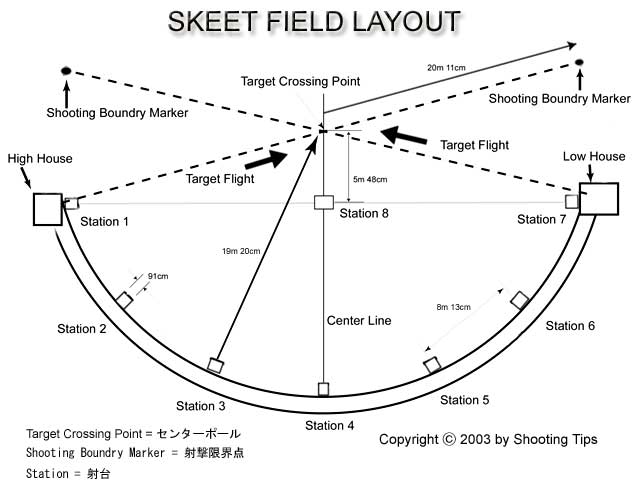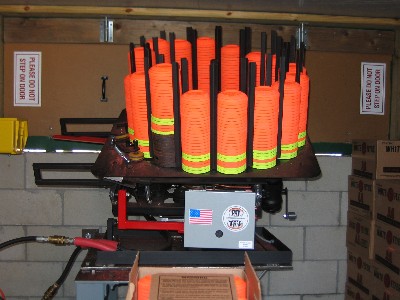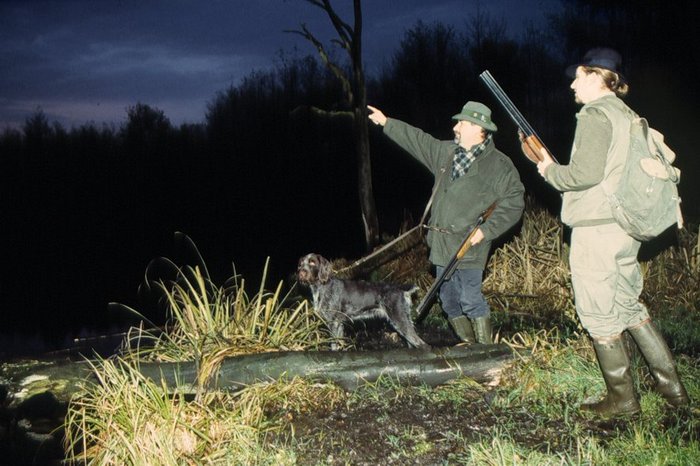A German hunting license is a certificate that grants its holder the exercise of hunting within legal ordinances. It is also the precondition to own hunting arms and ammunition (unlimited number of rifles/shotguns and up to two handguns). The actual right to exercise hunting in a specific area is entitled to the respective landowners (if they own an area of more than 200 acres, otherwise all landowners of a municipality are integrated into an association) who may use their right for themselves or lease it. Depending on size and value of an hunting area a typical leasing rate may vary from about 10 to 100 USD per acre per year.
My German hunting license:
Additionally the lesse has to pay the landowner any damage by deers, wild hogs etc. The right to hunt is connected to the duty to care for all kind of animals listed by the hunting laws. For several species such as deers plans have to be developed by hunters and authorities, how many animals of a specified class and age may (or have to) be killed within a certain period of time. The purpose of the hunting license is to ensure that only well trained persons may exercise hunting.
Applicants must fulfill the following requirements: Successful graduation of a hunting exam, Certificate of a liability insurance for hunters, Personal trustworthiness (§ 5 German Weapons Act), Applicants must be at least 16 years for a Youth Hunting License, otherwise 18 years, Flawless Criminal record.
The hunting exam is a test of expertise with a high failure rate. To pass it, each applicant has to participate in a comprehensive, difficult instruction course which consists largely of the areas shooting (shotgun and rifle), theory (
esp. weaponry, local wildlife and habitat) and practise.
In practise the German system of examination for deer hunters (stalkers) is very much in line with the English DMQ level DSC2. Over the last ten years or so European countries in general have made efforts to harmonise the previously fragmented rules and regulations with parallels being taken from the more difficult UK system.
|
|
|
One of my film takes an interesting way into the fascinating world of the forest.
Starting from the question of what the wood figure and the small beechnuts have to do with each other, the community forest will be explored.
We get to know the benefits of forests for humans: it is the air filter and drinking water supplier, it offers recreation and relaxation.
And he provides us with his wood an environmentally friendly raw materials.
|
What is the work of the forester, people who work in the forest, how they harvest the wood, which is also seen. The plot full circle in a factory for wooden toys. The film informs not exhaustive. Rather, he raises questions and to motivate yourself to go on an expedition in the forest, smell, feel, taste and observ
Skeet Shooting
History and general principles
 |
|
Skeet was invented by Charles E. Davies, an avid grouse hunter, in 1915 and evolved to its current setup by 1923. It originally used live pigeons but eventually changed to clay. In 1926 a contest was held to name the new sport, and Gertrude Hurlbutt named it skeet, which is derived from the Scandinavian word for "shoot". During World War II, Skeet was used in the American military to teach gunners the principle of leading and timing on flying targets.
|

Skeet is a recreational and competitive activity where participants attempt to break clay disks flung into the air at high speed from a variety of angles. The firearm of choice for this task is usually a high quality shotgun although many shooters of American skeet (see below) and other national versions still use inexpensive semi-auto and pump action shot guns with great success. The use of clay targets replaced the more traditional target of live birds, as a cheaper, humane and more reliable alternative, one reason they are also called clay pigeons.
 |
|
The event is in part meant to simulate the action of bird hunting. The shooter shoots from 7 positions on a semi-circle, and an 8th position halfway between stations 1 and 7. There are two houses that hold devices known as "traps" that launch the targets, one at each corner of the semi-circle. The traps launch the targets to a point 15 feet above ground and 18 feet outside of station 8. One trap launches targets from 10 feet above the ground ("high" house) and the other launches it from 3 feet above ground ("low" house).
At stations 1 and 2 the shooter shoots at single targets launched from the high house and then the low house, then shoots a double where the two targets are launched simultaneously. At stations 3 through 5 the shooter shoots at single targets launched from the high house and then the low house.
|
At stations 6 and 7 the shooter shoots at single targets launched from the high house and then the low house, then shoots a double. At station 8 the shooter shoots one high target and one low target. The shooter must reshoot his first missed target, or if no targets are missed, must shoot his 25th shell at the low house station 8. This 25th shot was once referred to as the shooter's option as he was able to take it where he preferred. Now, to speed up rounds in competition, the shooter must shoot the low 8 twice for a perfect score.
Trapshooting
Trapshooting was developed in England late in the 18th century. The first targets were live pigeons, which were released from cages known as traps. The sport was first practiced in the United States early in the 19th century and was popular by midcentury in a number of areas, notably Cincinnati, Ohio, and the New York City area. In subsequent decades the scarcity of live pigeons prompted trapshooting enthusiasts in the United States to create ingenious artificial targets. The substitute targets first tried included glass balls filled with feathers and solid iron pigeons mounted on long metal rods. Platter-shaped clay pigeons were developed about 1870. The subsequent introduction of standard-ized traps facilitated nationwide competition.

Trapshooting competition takes three forms: singles, handicap, and double-target shooting. In all three the targets are hurled from one trap, and 12-gauge shotguns are used. In singles shooting, contestants fire from a series of five stations located 16 yd (14.63 m) behind the trap. At a signal from the contestant, the clay target is hurled forward into the air, away from the firing line. In order to simulate the unpredictable flight patterns of birds taking wing, the targets are sprung out of the trap at various angles and in various directions. The clay pigeons rise to a minimum height of about 10 ft (about 3 m) and, unless hit, fall to the ground about 150 ft (about 45 m) from the trap. Champions often hit 100 out of 100 targets.

In handicap trapshooting, contestants possessing superior records must shoot from stations located 17 to 27 yd (15.54 to 24.68 m) behind the trap. The added distance, or handicap, enables trapshooters of only average ability to compete on equal terms with experts. In double-target shooting, the trap springs two clay pigeons into the air simultaneously in different directions.
 |
|
A variant of standard trap is Wobble or Wobble trap. The main differences are a much more extreme target flight path than in standard trap shooting (the trap oscillates up and down as well as side to side), shooters are allowed two shots per pull, and shooters at stations 1 and 5 stand at the 18 yard (16.5 m) mark while positions 2-4 stand at the 17 yard (15.5 m) mark. Although this version of trap is not sanctioned by the ATA, many shooters consider it to be both more challenging and engaging as well as a more realistic preparation for bird hunting. More experienced shooters will often shoot from the Skeet positions to increase the difficulty.
|












